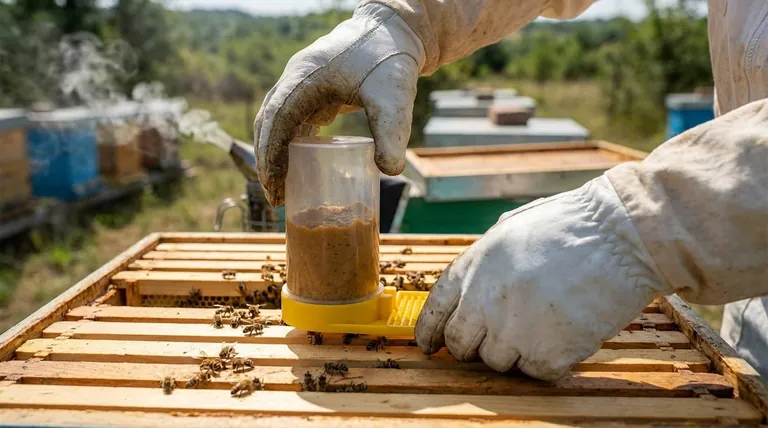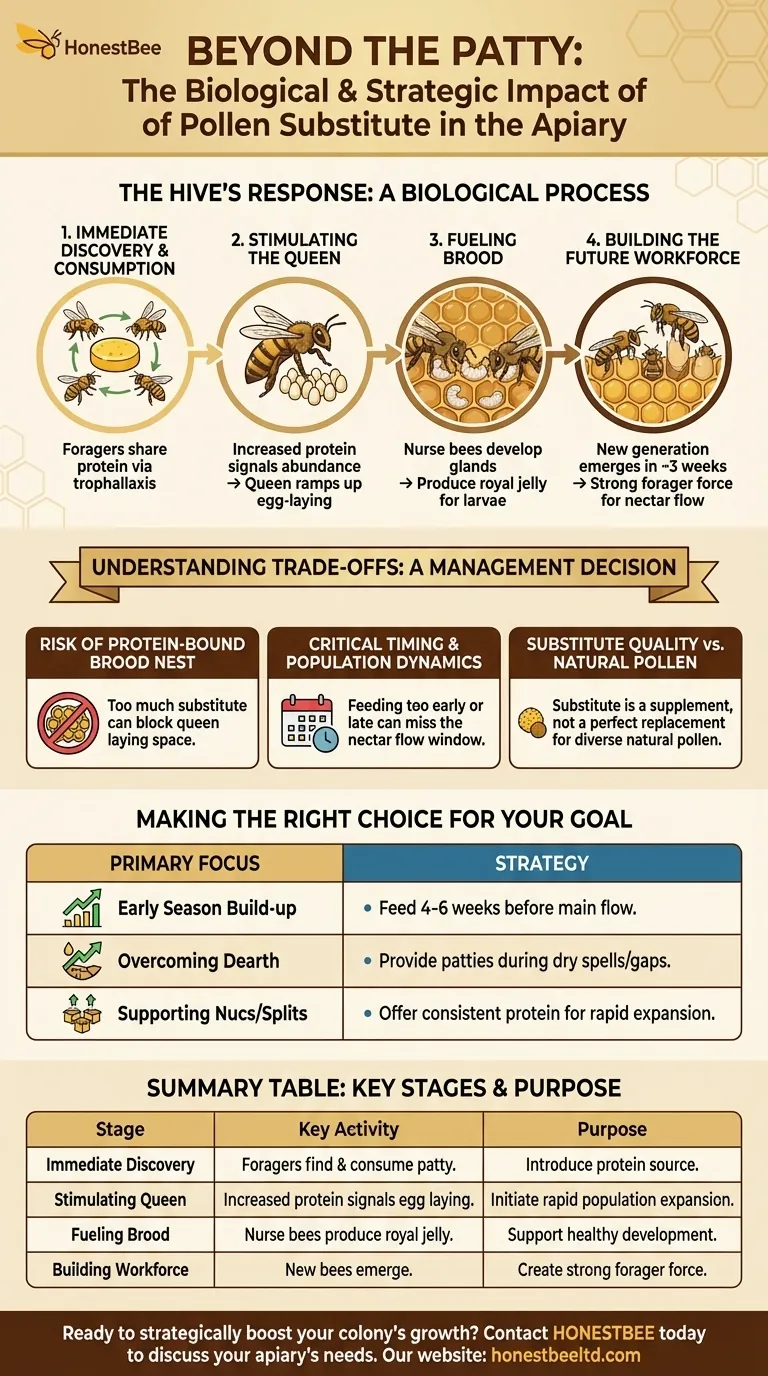Once the pollen substitute is placed inside the hive, the beekeeper's immediate task is to secure the colony. This involves replacing the inner cover or crown board directly over the substitute patty and then putting the main roof back on. These simple actions protect the feed from the elements, keep it soft and palatable for the bees, and secure the hive.
Placing pollen substitute is not the end of a task, but the beginning of a strategic biological process. You are providing the fuel that signals to the queen and the colony that it is time to ramp up brood production and expand the population.

The Hive's Response to a Protein Source
The placement of a pollen substitute is a powerful stimulus for a honey bee colony. The beekeeper's work is done for the moment, but the colony's work is just beginning.
Immediate Discovery and Consumption
Forager bees located in the top of the hive will almost immediately discover the new food source. They will begin to consume the patty, sharing it with other bees in the hive through trophallaxis (mouth-to-mouth feeding).
Stimulating the Queen to Lay
The most critical reaction happens next. The increased availability of protein signals to the entire colony that resources are abundant. This triggers the nurse bees to produce more royal jelly, which in turn stimulates the queen to dramatically increase her egg-laying rate.
Fueling a New Generation of Brood
The substitute is primarily consumed by nurse bees. They use this protein to develop their hypopharyngeal glands, which produce the royal jelly and other brood food necessary to feed the growing number of larvae. Without adequate protein, the colony cannot raise its young.
Building the Future Workforce
This entire process—from consumption to increased egg-laying—is aimed at one goal: building the colony's population. The brood that is raised on this substitute will emerge as adult bees in approximately three weeks, creating the strong workforce needed for an upcoming nectar flow.
Understanding the Trade-offs of Supplemental Feeding
While highly effective, using pollen substitutes is a management decision that requires an understanding of the potential downsides.
The Risk of a "Protein-Bound" Brood Nest
If you feed too much substitute without ensuring the queen has ample space to lay, the bees may pack the protein into empty brood cells. This can block the queen and restrict brood rearing, defeating the purpose of feeding.
Critical Timing and Population Dynamics
Feeding too early in the season can create a large population of bees with nothing to forage, increasing the risk of starvation if a cold snap occurs. Feeding too late will miss the window to build up the population in time for the main nectar flow.
Substitute Quality vs. Natural Pollen
No pollen substitute is a perfect replacement for the diverse nutrition provided by natural pollen from a variety of floral sources. While essential for stimulating growth, it should be seen as a supplement or temporary replacement, not a long-term dietary staple.
Making the Right Choice for Your Goal
Placing the pollen substitute is the first step; monitoring the hive's response and adjusting your strategy is the mark of an experienced beekeeper.
- If your primary focus is early season build-up: Begin feeding 4-6 weeks before your area's main nectar flow to ensure a massive forager workforce is ready to fly.
- If your primary focus is overcoming a pollen dearth: Provide patties during dry spells or late-season gaps to prevent a costly break in the colony's brood cycle.
- If your primary focus is supporting nucs or splits: Offer a consistent protein source to give these small colonies the resources they need for rapid expansion.
Ultimately, supplemental feeding is a tool to strategically direct your colony's growth and ensure its success.
Summary Table:
| Stage | Key Activity | Purpose |
|---|---|---|
| Immediate Discovery | Forager bees find and consume the patty. | Introduce the protein source to the colony. |
| Stimulating the Queen | Increased protein signals the queen to lay more eggs. | Initiate rapid population expansion. |
| Fueling Brood | Nurse bees use protein to produce royal jelly for larvae. | Support the healthy development of the new generation. |
| Building Workforce | New bees emerge approximately three weeks later. | Create a strong forager force for the nectar flow. |
Ready to strategically boost your colony's growth?
At HONESTBEE, we understand that timing and quality are everything. We supply commercial apiaries and beekeeping equipment distributors with the high-quality pollen substitutes and feeding equipment needed to effectively manage hive populations and maximize honey production.
Let our wholesale-focused operations support your success. Contact HONESTBEE today to discuss your apiary's needs.
Visual Guide

Related Products
- HONESTBEE Professional Entrance Bee Feeder Hive Nutrition Solution
- Wooden Bee Brush with Triple Row Artificial Fiber for Beekeeping
- Professional Galvanized Hive Strap with Secure Locking Buckle for Beekeeping
- Wooden Bee Brush with Double-Row Horsehair Bristles
- HONESTBEE Advanced Ergonomic Stainless Steel Hive Tool for Beekeeping
People Also Ask
- What are the different types of honey bee feeders? Choose the Right Feeder for Your Hive
- How does the entrance feeder method work? A Guide to Simple But Risky Hive Feeding
- How do you make an entrance feeder for bees? A Guide to Safe & Effective Hive Feeding
- How is the mesh ladder and barrier installed in the feeder box? A Step-by-Step Guide to Prevent Bee Drowning
- What is the best feeder for bees? Choose the Right Feeder for Your Hive's Success



















